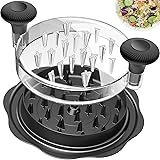Hearth Transformation: Guide to Installing Wood Burner in Your Fireplace

Ukeetap 10" Pro Chicken Shredder Tool Twist Large for Kitchen, BPA-Free Food-Safe Meat Grinder, Visible Chicken Breast Meat Shredder with Strong Anti-Slip Bottom & Ergonomic Handle, Black
$9.99 (as of November 11, 2025 23:21 GMT +00:00 - More infoProduct prices and availability are accurate as of the date/time indicated and are subject to change. Any price and availability information displayed on [relevant Amazon Site(s), as applicable] at the time of purchase will apply to the purchase of this product.)Electric Salt and Pepper Grinder Set - Rechargeable Automatic Salt and Pepper Shakers, Kitchen Appliances with External Adjustable Coarseness, Larger Hopper for Cooking, Home Gifts(2 Pack,Black/Black)
$23.99 (as of November 11, 2025 23:21 GMT +00:00 - More infoProduct prices and availability are accurate as of the date/time indicated and are subject to change. Any price and availability information displayed on [relevant Amazon Site(s), as applicable] at the time of purchase will apply to the purchase of this product.)BNBUN Bamboo Cutting Board for Kitchen, Wooden Cutting Board 3-Piece Set with Non-Slip Mat Deep Juice Groove and Built-In Handles, Wood Cutting Board for Meat Vegetables Fruit Ideal Gift for the Home
$29.99 (as of November 11, 2025 23:21 GMT +00:00 - More infoProduct prices and availability are accurate as of the date/time indicated and are subject to change. Any price and availability information displayed on [relevant Amazon Site(s), as applicable] at the time of purchase will apply to the purchase of this product.)Bidobibo Bear Straw Cup, Cute Baby Straw Cups Glass, Honey Bear Cup with Straws, Cute Mugs for Coffee Drinks 20oz (1 PC)
$29.99 (as of November 11, 2025 23:21 GMT +00:00 - More infoProduct prices and availability are accurate as of the date/time indicated and are subject to change. Any price and availability information displayed on [relevant Amazon Site(s), as applicable] at the time of purchase will apply to the purchase of this product.)Food Vacuum Sealer Machine, 75KPA Strong Suction, Dry/Wet Modes, 20 Vacuum Seal Bags for Food, Digital Countdown Timer, Compact Lightweight, Ideal for Home Kitchen Use
$24.99 (as of November 11, 2025 23:21 GMT +00:00 - More infoProduct prices and availability are accurate as of the date/time indicated and are subject to change. Any price and availability information displayed on [relevant Amazon Site(s), as applicable] at the time of purchase will apply to the purchase of this product.)8 Blade All-in-1 Vegetable Chopper Mandoline Slicer with Container, Food Chopper, Onion Chopper, Veggie Cutter for Salad, Kitchen Gadgets Accessories Essentials, White
$19.99 (as of November 11, 2025 23:21 GMT +00:00 - More infoProduct prices and availability are accurate as of the date/time indicated and are subject to change. Any price and availability information displayed on [relevant Amazon Site(s), as applicable] at the time of purchase will apply to the purchase of this product.)FUMMDUS Meat Thermometer Digital, 3S Instant Read Food Thermometer for Cooking with Backlight & Magnet, Foldable Temperature Probe Kitchen Gadgets Essentials for Turkey BBQ Grill Smoker Candy
$9.99 (as of November 11, 2025 23:21 GMT +00:00 - More infoProduct prices and availability are accurate as of the date/time indicated and are subject to change. Any price and availability information displayed on [relevant Amazon Site(s), as applicable] at the time of purchase will apply to the purchase of this product.)Amazon Basics Organic Cotton Waffle Kitchen Dish Towels - Ultra Absorbent, Quick Drying, Lint-Free, 15 x 25 inches, 6-Pack (4 Navy Strip/Checker, 1 White, 1 Solid Navy)
Now retrieving the price.
(as of November 11, 2025 23:21 GMT +00:00 - More infoProduct prices and availability are accurate as of the date/time indicated and are subject to change. Any price and availability information displayed on [relevant Amazon Site(s), as applicable] at the time of purchase will apply to the purchase of this product.)Warming Mat for Food Extra Large 32"x15", Electric Silicone Food Warmer Trays for Chafing Dishes & Buffet,Portable Countertop Food Warmers for Parties, 7-Level Temp 8-Hour Timer, Blue
$49.99 (as of November 11, 2025 23:21 GMT +00:00 - More infoProduct prices and availability are accurate as of the date/time indicated and are subject to change. Any price and availability information displayed on [relevant Amazon Site(s), as applicable] at the time of purchase will apply to the purchase of this product.)F-Caw-F Funny Chicken Humor F-Caw-F Quote Rooster Meme Stainless Steel Insulated Tumbler
$18.69 (as of November 11, 2025 23:21 GMT +00:00 - More infoProduct prices and availability are accurate as of the date/time indicated and are subject to change. Any price and availability information displayed on [relevant Amazon Site(s), as applicable] at the time of purchase will apply to the purchase of this product.)For many homeowners, the allure of a crackling wood fire is undeniable. It represents warmth, comfort, and a connection to simpler times. Yet, if you have a traditional open fireplace, you’ve likely experienced its inefficiencies firsthand—most of the heat disappears up the chimney, and the constant draft can make the rest of your house feel colder. This leads to a pivotal question many are asking: can I put a wood burner in my fireplace?
The short, exciting answer is yes, in most cases, you absolutely can. Installing a wood-burning stove or insert into an existing fireplace is not only possible but is one of the most effective home upgrades for improving heating efficiency and ambiance. However, this transformation is not as simple as just sliding a new appliance into the old opening. It requires careful planning, a understanding of safety regulations, and professional expertise to ensure the system operates effectively and safely.
This definitive guide will walk you through every aspect of the process. We will explore the compelling reasons to make the switch, detail the crucial feasibility checks for your existing fireplace, and compare your installation options. You will learn about the necessary components like chimney liners, understand the investment required, and discover how to maintain your new wood burner for a lifetime of efficient, cozy warmth.
Why Install a Wood Burner in Your Existing Fireplace? The Compelling Benefits
Replacing an old, inefficient fireplace with a modern wood burner offers a suite of advantages that go far beyond mere aesthetics.
Dramatically Improved Heating Efficiency
This is the single biggest reason for making the change. A traditional open fireplace is notoriously inefficient, operating at a paltry 5% to 15% efficiency. This means over 85% of the heat generated by your fire is lost up the chimney. Modern wood stoves and inserts, on the other hand, are engineering marvels of efficiency. EPA-certified models can achieve efficiency ratings of 70% to 83%. They are designed to completely combust the wood gases and particles, extracting the maximum possible heat from every log and releasing far fewer emissions. This translates to a warmer home and significantly less wood consumption.
Significant Cost Savings on Heating Bills
By harnessing vastly more heat from the same amount of wood, a wood burner directly reduces your reliance on fossil fuels or electricity for heating. This can lead to substantial savings on your annual energy bills. Furthermore, if you have access to a free or low-cost supply of firewood, your primary heating cost can be reduced to just the labor of processing it.
Enhanced Safety and Peace of Mind
Open fireplaces pose inherent risks, from flying sparks to intense radiant heat on the surrounding hearth. Modern wood burners are fully enclosed, typically behind a glass door, containing sparks and embers completely. This sealed system is far safer for households with children and pets. Additionally, the controlled combustion produces less of the flammable substance called creosote, which is a leading cause of chimney fires in traditional fireplaces.
Superior Ambiance and Reliable Backup Heat
While more efficient, a wood burner loses none of the romantic appeal of a real wood fire. You still enjoy the authentic flicker of flames and the comforting radiant heat. Crucially, a wood stove provides excellent emergency heating during power outages, something electric heat pumps and many gas furnaces cannot do. This makes it a valuable resilience feature for any home.
A Positive Environmental Choice
When burned in a modern, efficient appliance, wood is considered a carbon-neutral fuel. The carbon dioxide released during combustion is roughly equal to what the tree absorbed during its lifetime. By switching from an open fireplace to a high-efficiency wood burner, you dramatically reduce particulate emissions, making wood a more sustainable heating choice.
The First Step: Is Your Fireplace a Candidate for a Wood Burner?

Before you fall in love with a particular stove model, you must determine if your fireplace and chimney can accommodate the installation. Not every fireplace is a suitable candidate.
Assessing Your Chimney and Flue
The chimney is the lungs of your wood-burning system, and its condition is paramount. The first thing to verify is that you have a Class 1 chimney, which is designed for solid fuel appliances like wood stoves. If your home previously had a gas fireplace, the flue may not be suitable and would require significant modification or replacement.
You must also consider the flue size. Most modern wood stoves require a flue with a minimum diameter of 6 inches. Connecting a stove to an improperly sized flue can lead to poor draft, smoke spillage, and dangerous creosote buildup. A professional inspection is the only way to confirm your chimney’s status and suitability.
Understanding the Critical Role of a Chimney Liner
One of the most common and necessary components of a fireplace conversion is the installation of a stainless steel chimney liner. An old masonry chimney often has cracks, gaps, or is simply too large for a modern stove to function correctly. A large, cold flue can cool the exhaust gases too quickly, killing the draft and causing creosote to condense on the inner walls.
An insulated stainless steel liner solves these problems by:
- Creating a smooth, properly sized pathway for smoke and gases.
- Improving draft and overall stove performance.
- Heating up quickly to reduce creosote formation.
- Protecting the old masonry from corrosive combustion byproducts.
As experienced installers on professional forums note, insulating the liner is a step you will “not regret,” as it significantly improves performance and safety.
Evaluating Your Fireplace Dimensions and Hearth
You need to know the exact dimensions of your firebox—width, height, and depth. This will determine whether a freestanding stove can fit inside or if you need an insert. The hearth (the non-combustible floor in front of and around the fireplace) must also meet current safety codes. Regulations typically require the hearth to extend at least 300mm (12 inches) in front of the stove and 150mm (6 inches) to each side. This hearth must be made of a non-combustible material like tile, stone, or brick, and be in good condition without cracks.
Your Two Main Installation Options: Wood Stove Inserts vs. Freestanding Stoves
When converting your fireplace, you have two primary paths to choose from, each with its own advantages.
The Fireplace Insert
A wood stove insert is a unit specifically designed to be slid directly into the opening of your existing fireplace. It fits snugly within the firebox, with only its faceplate visible on the hearth.
- Pros: Inserts are a space-saving solution that provides a very clean, built-in look. They are fantastic for converting the inefficiency of an open fireplace into powerful, directed heat. Many models come with built-in blowers that actively force warm air into the room, making them highly effective at heating the space they are in.
- Cons: Because they are recessed, they primarily function as convection heaters. Some users feel they lack the same intense radiant heat feel of a freestanding stove. They also typically require electricity to run the blower for optimal heat distribution.
The Freestanding Wood Stove
A freestanding stove is installed either partially within the fireplace opening or fully out on the hearth, connected to the flue via a short section of stovepipe.
- Pros: Freestanding stoves are renowned for their classic, radiant heat, which warms objects and people directly, similar to the sun. Many homeowners prefer this heating sensation. As one user of a freestanding Jotul stove noted, “I have no need for a fan with this setup – The stove radiates nicely”. They can also become a more prominent visual centerpiece in the room.
- Cons: This option requires more space in front of the fireplace. It also demands careful measurement to ensure the stove and its required clearances will fit properly on your hearth.
Table: Wood Stove Insert vs. Freestanding Stove – A Quick Comparison
| Feature | Wood Stove Insert | Freestanding Stove |
|---|---|---|
| Installation Location | Inside the existing firebox | On the hearth, in front of the fireplace |
| Primary Heat Type | Convection (with fan assistance) | Radiant |
| Aesthetic | Built-in, seamless look | Prominent, classic stove appearance |
| Space Requirement | Minimal, ideal for smaller rooms | Requires more floor space in front of hearth |
| Blower/Fan | Usually required for effective heat distribution | Not required; provides radiant heat without one |
| Best For | Maximizing heat output from the fireplace space | Traditional radiant heat and stove ambiance |
The Professional Installation Process: What to Expect
A safe and code-compliant installation is not a DIY project. It requires the skill of a certified professional. Here is an overview of the steps they will take.
- Initial Inspection and Measurement: A certified technician will inspect your chimney structure, measure your flue, and assess your fireplace and hearth to recommend the best stove options for your situation.
- Chimney Preparation and Liner Installation: This often involves removing the old damper to make room for the new liner. An insulated stainless steel liner is then dropped down the chimney and connected to a special support at the top.
- Hearth Preparation and Stove Placement: The technician will verify that your existing hearth meets clearance requirements. If it doesn’t, you will need to extend it with non-combustible materials before the stove can be placed.
- Connecting the Stove to the Flue: For a freestanding stove, this involves connecting a section of stovepipe (single-wall or double-wall) from the stove’s flue collar to the liner inside the chimney. Inserts typically connect directly to the liner through a special block-off plate that seals the fireplace opening.
- Final Sealing and Safety Check: All connections are sealed, and the system is checked for proper draft. The installer will also ensure that a carbon monoxide detector is fitted in the same room as the stove, which is a legal requirement for safe operation.
Understanding the Investment: Cost Breakdown
The total cost of converting your fireplace to a wood burner can vary widely based on your existing setup and the products you choose.
- The Appliance: The wood stove or insert itself can range from $1,900 to over $5,000, depending on the brand, size, features, and efficiency rating.
- Chimney Liner and Components: An insulated stainless steel liner is a significant part of the cost, often ranging from $1,500 to $3,000 installed, depending on the height of your chimney and the type of liner chosen.
- Installation Labor and Permits: Professional installation is crucial and can cost between $500 and $2,000, depending on the complexity of the job. Don’t forget to factor in the cost of any required building permits.
While the upfront investment is substantial, the long-term savings on heating bills and the added value to your home can make it a financially sound decision over time.
Essential Safety and Maintenance for Your Wood Burner
Once installed, proper operation and maintenance are key to safety and performance.
Annual Inspection and Cleaning: Have your entire system—stove, liner, and chimney—inspected and cleaned by a qualified professional at least once a year. This is non-negotiable for preventing chimney fires.
Safe Burning Practices: Only burn dry, seasoned hardwood that has been split and stored for at least 6-12 months. Never burn treated wood, plastic, or garbage, as these can release toxic fumes and accelerate creosote buildup. Avoid using accelerants like lighter fluid, which are extremely dangerous in an enclosed appliance.
Proper Ash Disposal: Regularly remove ashes into a dedicated metal container with a tight-fitting lid. Always ensure the ashes are completely cool before disposing of them.
Maintain Clearances: Keep all flammable materials—including furniture, curtains, and firewood—at least three feet away from the stove.
Final Verdict: Can I Put a Wood Burner in My Fireplace?
So, can I put a wood burner in my fireplace? The evidence confirms that you can, and for most homeowners, it is a profoundly beneficial upgrade. By converting your inefficient open fireplace to a modern wood stove or insert, you gain dramatic improvements in heating efficiency, cost savings, safety, and home comfort.
The process requires a professional assessment of your chimney, a likely investment in a new stainless steel liner, and a commitment to proper installation and maintenance. However, the reward is a reliable, cozy, and powerful heat source that will serve as the heart of your home for many winters to come. Take the first step by consulting with a certified hearth professional, and you’ll be well on your way to transforming your hearth and your home.




















